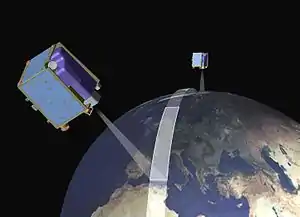Earth exploration-satellite service
Earth exploration-satellite service (also: Earth exploration-satellite radiocommunication service) is – according to Article 1.51 of the International Telecommunication Union´s (ITU) Radio Regulations (RR)[1] – defined as «A radiocommunication service between earth stations and one or more space stations, which may include links between space stations, in which:
- information relating to the characteristics of the Earth and its natural phenomena, including data relating to the state of the environment, is obtained from passive or active sensors on satellites;
- similar information is collected from airborne or Earth-based platforms;
- such information may be distributed to earth stations within the system concerned;
- platform interrogation may be included.

This service may also include feeder links necessary for its operation.»
Classification
This radiocommunication service is classified in accordance with ITU Radio Regulations (article 1) as follows:
Fixed service (article 1.20)
- Fixed-satellite service (article 1.21)
- Inter-satellite service (article 1.22)
- Earth exploration-satellite service
- Meteorological-satellite service (article 1.52)
Frequency allocation
The allocation of radio frequencies is provided according to Article 5 of the ITU Radio Regulations (edition 2012).[2]
In order to improve harmonisation in spectrum utilisation, the majority of service-allocations stipulated in this document were incorporated in national Tables of Frequency Allocations and Utilisations which is with-in the responsibility of the appropriate national administration. The allocation might be primary, secondary, exclusive, and shared.
- primary allocation: is indicated by writing in capital letters (see example below)
- secondary allocation: is indicated by small letters
- exclusive or shared utilization: is within the responsibility of administrations
However, military usage, in bands where there is civil usage, will be in accordance with the ITU Radio Regulations.
- Example of frequency allocation
| Allocation to services | ||
| Region 1 | Region 2 | Region 3 |
401-402 MHz METEOROLOGICAL AIDS
| ||
13.4-13.75 GHz EARTH EXPLORATION-SATELLITE (active)
| ||
Classification
In accordance with ITU Radio Regulations (article 1) variations of this radiocommunication service are classified as follows:
Fixed service (article 1.22)
- Earth exploration-satellite service' (article 1.51)
- Meteorological-satellite service (article 1.52)
See also
References / sources
- ITU Radio Regulations, Section IV. Radio Stations and Systems – Article 1.51, definition: earth exploration-satellite service / earth exploration-satellite radiocommunication service
- ITU Radio Regulations, CHAPTER II – Frequencies, ARTICLE 5 Frequency allocations, Section IV – Table of Frequency Allocations
- International Telecommunication Union (ITU)
- Earth exploration-satellite service. ITU, Genf 2011. ISBN 92-61-13761-X